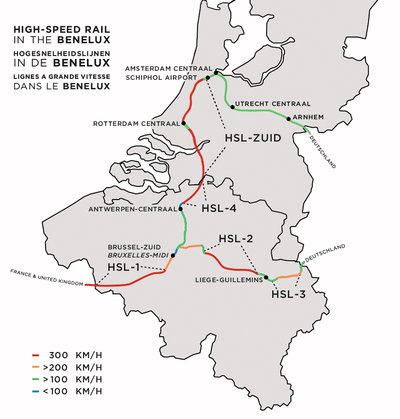HSL 4
| HSL 4 | |||||||||||||||||||||||||||||||||||||||
|---|---|---|---|---|---|---|---|---|---|---|---|---|---|---|---|---|---|---|---|---|---|---|---|---|---|---|---|---|---|---|---|---|---|---|---|---|---|---|---|
 The HSL 4 and HSL-Zuid rail lines | |||||||||||||||||||||||||||||||||||||||
| Overview | |||||||||||||||||||||||||||||||||||||||
| Status | Operational | ||||||||||||||||||||||||||||||||||||||
| Locale | Belgium | ||||||||||||||||||||||||||||||||||||||
| Termini |
Antwerpen-Luchtbal railway station Dutch border | ||||||||||||||||||||||||||||||||||||||
| Operation | |||||||||||||||||||||||||||||||||||||||
| Opening | 2009 | ||||||||||||||||||||||||||||||||||||||
| Operator(s) | National Railway Company of Belgium | ||||||||||||||||||||||||||||||||||||||
| Technical | |||||||||||||||||||||||||||||||||||||||
| Line length | 36 km (22 mi) | ||||||||||||||||||||||||||||||||||||||
| No. of tracks | double track | ||||||||||||||||||||||||||||||||||||||
| Track gauge | 1,435 mm (4 ft 8 1⁄2 in) standard gauge | ||||||||||||||||||||||||||||||||||||||
| Electrification | 25 kV 50 Hz | ||||||||||||||||||||||||||||||||||||||
| Operating speed | 300 km/h (186 mph) | ||||||||||||||||||||||||||||||||||||||
| |||||||||||||||||||||||||||||||||||||||
The HSL 4 (Dutch: Hogesnelheidslijn 4, English: High-Speed Line 4) is a Belgian high-speed rail line part of the 87 km axis which connects Brussels to the Dutch border. 40 km long (36 kilometer of it dedicated high speed tracks), it was scheduled for completion by 2005 and opened in 2009.
Together with the HSL 1 to the French border and HSL-Zuid to Amsterdam, the line has shortened journeys between Brussels, Paris and the Netherlands. HSL 4 is used by Thalys trains and fast internal InterCity trains (Class 13 locomotives with I11 vehicles). It is also planned to be used by Fyra and, tentatively, Eurostar e320 and DB Baureihe 407 trains.
Route
The high-speed HSL 4 begins just after Antwerp, and runs 36 km where it meets the Dutch border.
From Brussels to Antwerp
Though HSL begins in Anwerp, it is part of a Paris-Brussels-Amsterdam corridor. High speed trains like Thalys, upon departing Brussels for Amsterdam, first use the existing, conventional track, electrified at 3 kV DC.
From Brussels South station, trains travel northwards through the Brussels-Central and Brussels-North stations. At Schaarbeek the line splits in two; the eastern branch continues to Liège and the German border, the northern branch towards Antwerp and the Dutch border. Between Brussels and Antwerp (47 kilometres), trains travel at 160 kilometres per hour on line 25N and then the upgraded existing line 25 (with the exception of a few segments where a speed limit of 100–120 km/h is imposed).
From Antwerp north
In Antwerp, a tunnel has been constructed underneath the city to permit high-speed trains to run directly through Antwerpen-Centraal to the new high-speed line north, an extension of line 25 until Luchtbal station, after which line 4 (HSL 4) starts. Trains enter the 1.5-kilometre long, two-tube tunnel past Berchem at 90 kilometres per hour. They exit the tunnel at 40 km/hour, it seems due to stability and infiltration concerns.
The line surfaces at Antwerpen-Dam as line 25, and after crossing the Albert Canal, crosses the existing Antwerp-Essen line at 120 km/h. At the E19/A12 motorway junction, trains leave the regular line to run on new dedicated high-speed tracks to the Dutch border (40 kilometres away) at up to 300 kilometres per hour. The route parallels the E19 motorway until the border, which has required the building of several bridges.
The line passes through Schoten, Brasschaat, Brecht, Wuustwezel, and Hoogstraten, before crossing the border into the Netherlands and connecting to the Dutch HSL-Zuid.
Stations
Antwerpen-Centraal station has been completely reorganised. A tunnel has been constructed to permit the passage of trains under the city, additionally creating a subterranean junction between Berchem station and Antwerpen-Dam station, passing through Antwerpen-Centraal. With these works completed, the station has four levels and 14 tracks:
- level +1 (the original station) has 6 terminating tracks, arranged as two groups of three and separated by an opening allowing natural light to reach the lower levels
- level 0 contains ticketing facilities and commercial space
- level −1 (7 meters below road level) has 4 terminating tracks, also arranged as two groups
- level −2 (18 meters below road level) has 4 tracks, which end up in the two-track-wide tunnel under the city (used by high-speed trains and fast InterCity services)
The HSL 4 is the only high-speed line in Belgium that features an intermediate station at Noorderkempen (Brecht) for use in regular speed passenger service.
'Solar Tunnel'
The line features a 'Solar Tunnel' near Antwerp. The above-ground tunnel is comparable to a avalanche gallery except instead of snow it protects the trains from falling trees. It was constructed as an alternative to felling parts of the nearby forrest. The 'tunnel' is unique as it is covered with 16,000 solar panels. The line's operator claim this provides 3300 MWh of electricity per year and cuts CO2 emissions by 2400 tonnes a year.[1]
See also
External links
- Belgian high-speed rail site (French)
| Wikimedia Commons has media related to HSL 4. |
References
| ||||||||||||||||||||||||||||||||||||||||||||||||||||||||